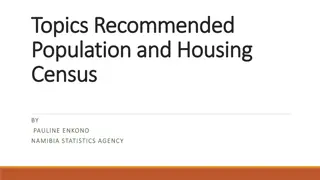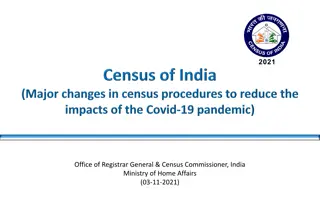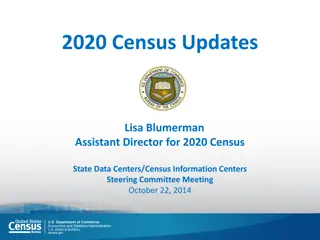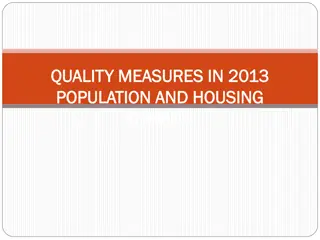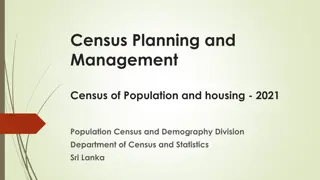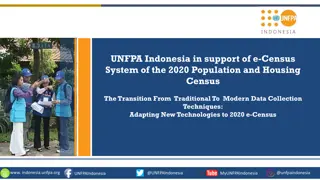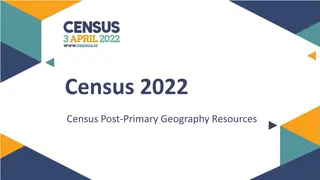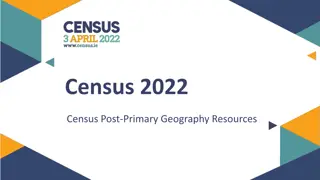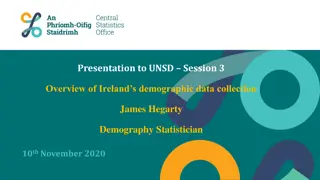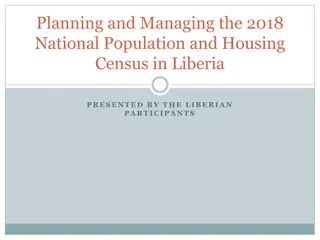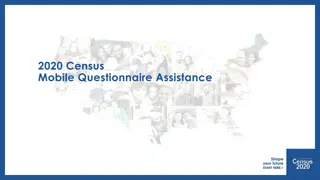Importance of Census 2020 for Fair Representation and Federal Funding
The Census 2020 regional coordination by Mid-America Regional Council and NARC highlights the significance of achieving a complete count for fair allocation of over $675 billion in federal funding across 132 programs. Challenges include distrust of government, mobility of population, and reaching hard-to-count populations like renters, immigrants, and those with limited English proficiency. The enumeration process involves hiring enumerators, group quarters enumeration, and non-response follow-up to ensure accurate tabulation by November 2020.
Download Presentation

Please find below an Image/Link to download the presentation.
The content on the website is provided AS IS for your information and personal use only. It may not be sold, licensed, or shared on other websites without obtaining consent from the author.If you encounter any issues during the download, it is possible that the publisher has removed the file from their server.
You are allowed to download the files provided on this website for personal or commercial use, subject to the condition that they are used lawfully. All files are the property of their respective owners.
The content on the website is provided AS IS for your information and personal use only. It may not be sold, licensed, or shared on other websites without obtaining consent from the author.
E N D
Presentation Transcript
2020 CENSUS Regional Coordination Mid-America Regional Council NARC National Conference of Regions February 11, 2019
Fair representation What s at stake in 2020? the importance of a complete count. Fair allocation of federal $$ $675 billion for 132 federal programs Information for planning and decision making
November 2019 Hiring enumerators begins Get Out the Count promotion How will the Census Bureau conduct the count in 2020? March 2020 Postcards mailed Respond online Paper survey
February-April 2020 Group quarters enumeration How will the Census Bureau conduct the count in 2020? May 2020 -July 2020 Non-response follow-up November 2020 Census Bureau completes tabulation
Distrust of government Mobility of population Challenges achieving a complete count Increased diversity More non-English speaking citizens
Informal living arrangements Declining response rates Challenges achieving a complete count New survey methods Citizenship question Cybersecurity
Hard-to-count populations Limited English proficiency Very young children Immigrants Persons of color College students and young adults
Hard-to-count populations Renters Gated communities Homeless population Limited internet access
Jan-July 2018 Local Update of Census Addresses Role of regional council & local gov t April 2019-April 2020 New residential construction
Review and define census geography Role of regional council & local gov t Local communities will review: census block block group census tract boundaries
March 2019 Form regional CCC Support local CCCs MARC role to support a complete count in Metro KC June 2019 Develop communications and outreach plan Engage diverse community organizations
Raise funding MARC role to support a complete count in Metro KC Implement communications plan Traditional media, social media, news media and outreach with community partners Identify locations where residents can obtain assistance Address cybersecurity concerns
Resources & Information National League of Cities toolkit Census.gov/roam Database & mapping tool CUNY hard-to-count maps www.censushardtocountmaps2020.us/
Mapping Hard-to-Count Areas Wyandotte County, Kansas (CT 402) 1,310 people live in 445 households Only 67.1 percent completed 2010 census questionnaires 32.9 required in-person follow up
Marlene Nagel Community Development Director Contact Information Mid-America Regional Council 600 Broadway, Suite 200 Kansas City, MO 64105 816-701-8218 mnagel@marc.org






